We grow a rich harvest in the open field - the resistant tomato "Vityaz"
The Vityaz hybrid is suitable for growing in any conditions: under a film, in greenhouses, in open beds. Its fruiting rate does not suffer from growing conditions. This is the highest yielding tomato of all hybrids.
Fruits of the original color and shape are suitable not only for home consumption - they quickly disperse in sales markets. Entrepreneurs know about these qualities, so the culture is popular both in summer cottages and in farm fields.
The content of the article
Description of culture
The Vityaz f1 hybrid was the result of the development of Alexey Alekseevich Mashtakov... The Russian breeder conducts his work in the Rostov region, so his crops are excellent for our climate.
A hybrid culture with a similar name, the Russian Vityaz f1 tomato, was bred by breeders of the Sedek agricultural company. It is a mid-ripening hybrid, the fruits ripen 110-118 days after germination. The type of plants is indeterminate, the inflorescences are simple.
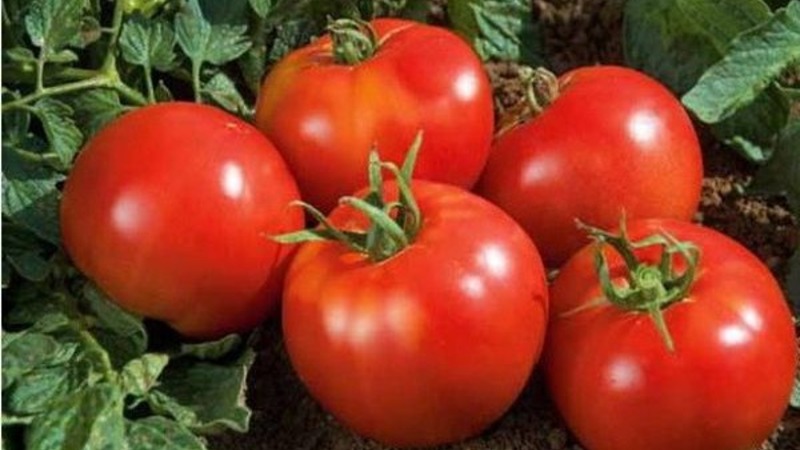
The culture is distinguished by strong immunity to diseases. The yield is high. Ripe pink fruits with excellent taste and average weight 250 g. The hybrid is recommended for breeding under film shelters in any region.
Distinctive features of the Vityaz tomato
Determinant type, up to 75 cm high... The foliage and branching are medium, the leaves are dark green. The inflorescences are simple, the first is formed above 7-8 leaves, the subsequent ones - after 1-2 leaves. Each brush lays 5-6 fruits, the ovaries are formed under any weather conditions.
Mid-season tomato, 110-130 days pass from the moment of sowing to full ripening. It takes root both in the open field and in greenhouse conditions. Plants tolerate drought and hot climates well.
The crop has a high yield rate: from 1 sq. m collect 6-10 kg of fruits.
The hybrid is resistant to diseases such as tobacco mosaic virus and Alternaria, but susceptible to late blight... For this reason, prevention is recommended.
Plants require compulsory garter and pinching.
Read also:
Tomato "Katrina f1" with powerful bushes and abundant harvest
Fruit characteristics
Average weight - 120-140 g, but with proper care it reaches 200 g... The shape is round, the color is bright red, the taste is excellent, semi-sweet with a barely perceptible sourness. The pulp is juicy, the seed chambers are 4–6, the peel is strong.
The original taste allows the universal use of ripe vegetables. They make excellent preserves (juices, pastes, ketchups, sauces, adjika, lecho) and a variety of fresh dishes.
Duration of storage allows you to transport tomatoes over long distances without losing the presentation. Thanks to these qualities, entrepreneurs use hybrid commercially.
The photo shows the Vityaz f1 tomatoes.
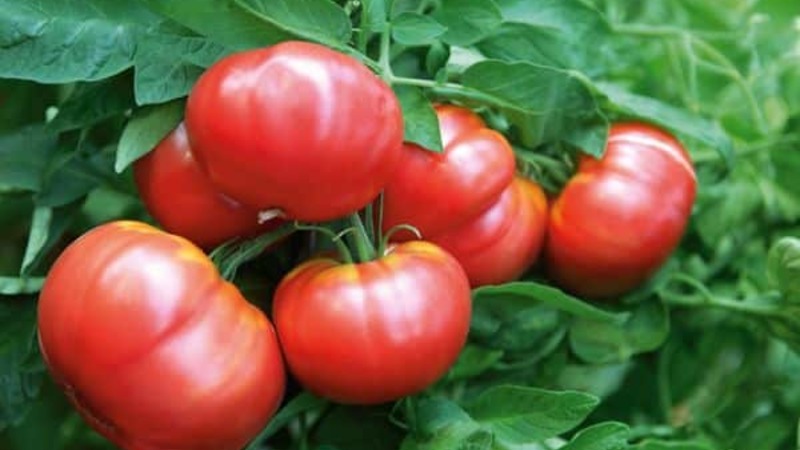
How to grow seedlings
Seeds are sown for seedlings 2 months before planting. Before sowing, carry out standard preparation.
Seed preparation
Seed material is determined by immersion in saline solution.... Those grains that float to the surface in 10 minutes are unsuitable for planting. Then the seeds are disinfected in a weak solution of potassium permanganate for 25 minutes.Then washed with running water and dried.
Important! A highly concentrated solution of manganese can destroy all the seed.
To improve germination, grains are germinated on damp gauze within three days, until the shoots appear. Gauze moistened with warm water is left in a dark, warm place at a temperature of 27 ° C. As it dries, it is re-moistened.
Capacity and soil
The container for planting is prepared in advance, making small holes at the bottom for drainage, where excess moisture will drain. Plus, drainage holes improve breathability.
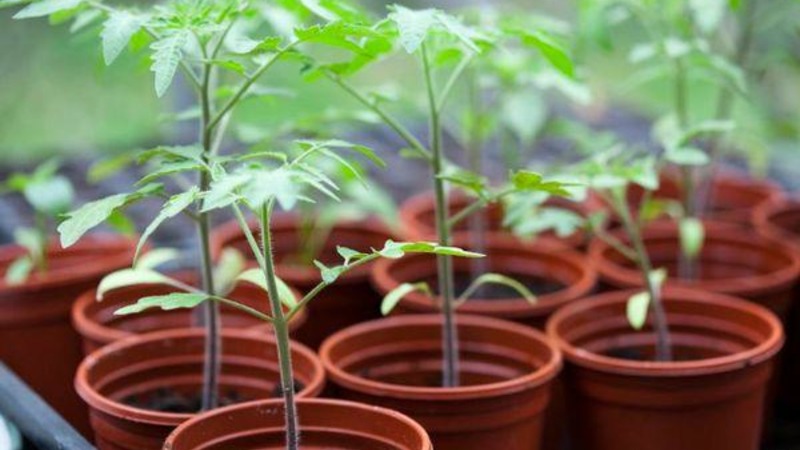
They are planted in a common container or in separate containerseg paper honeycombs, peat pots, plastic cups. Before sowing, containers must be treated with a dark solution of manganese. Disinfection is especially important if these containers have been used for previous plantings.
Reference. When sowing seeds in peat pots, picking the seedlings is not required. In addition, plants receive additional nutrition due to the content of nutrients in the walls of the containers.
The soil is prepared from garden soil, peat and humus in equal amounts... Washed river sand is added as a baking powder. The prepared mixture is spilled with a hot solution of potassium permanganate to destroy disease-causing spores. The cooled soil is laid out in planting containers, filling them by two-thirds.
Sowing
Seeds are sown in grooves 2 cm deep and at a distance of 3-4 cm from each other... Sprinkle with soil on top and compact slightly. After watering with warm, settled water, cover with a film and leave in a warm room at a temperature of 24-25 ° C.
Reference. When the containers are covered with a film, a greenhouse effect is created, due to which the seeds germinate faster.
Seedling care
When the first shoots appear, the film is immediately removed, otherwise the sprouts will wither from the heat. The containers are placed on the windowsill to obtain the required amount of light. Daylight hours are at least 13 hours. If there is not enough light, you should take care of additional lighting.
Reference. With a lack of light, the seedlings stretch out and weaken.
Water as the top soil layer dries warm settled water with an ordinary tablespoon. At the initial stage of development, it is important not to flood the sprouts, otherwise the increased level of humidity will negatively affect the root system. In addition, the risk of fungal infections increases. After watering, the soil is loosened, ensuring the air permeability of the soil.

When two true leaves appear, the seedlings dive, seating in separate containers. Before a dive, the ground is well moistened so that young bushes can be transplanted together with an earthen clod. Otherwise, the seedlings will painfully experience the dive. If the seedlings are left in a common box, the distance between them is increased to 15 cm.
When breeding in a common wooden box 10 days after the pick, the seedlings are fed with liquid fertilizer for tomatoes. The same is done in separate containers with poor growth.
2-3 weeks before transplanting, the seedlings begin to harden. for faster survival in the open field. To do this, the containers are taken out into the open air, first for 1 hour, and then the time interval is gradually increased to 10 hours.
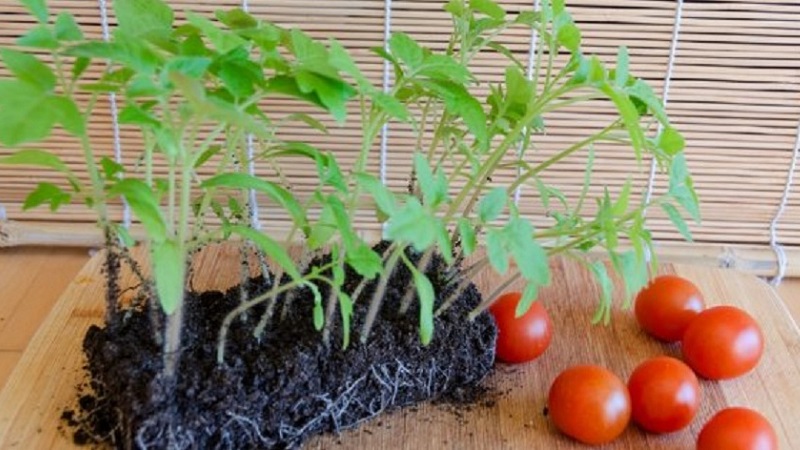
How to grow tomatoes
By the time of transplanting, the seedlings should have 5-7 true leaves and formed young roots.
Landing
The soil is prepared two weeks before transplanting.... They dig it up and add a complex of minerals. Do not forget that the hybrid is susceptible to late blight, therefore, tomato beds are spilled with copper sulfate.
Landing scheme: 40 cm - distance between seedlings, 60 cm - distance between rows. For 1 sq. m place 4-5 plants in a checkerboard pattern. With this planting method, each bush receives a sufficient amount of light and ventilation. This is especially important for those species that are susceptible to fungal diseases.
Further care
As they take root in the beds, the seedlings begin to regularly water and feed.... Water it sparingly, not exceeding humidity, but not leaving the soil dry. In order for the soil to retain moisture longer, the beds are mulched with straw or sawdust. After watering, the soil is loosened for better oxygen access.
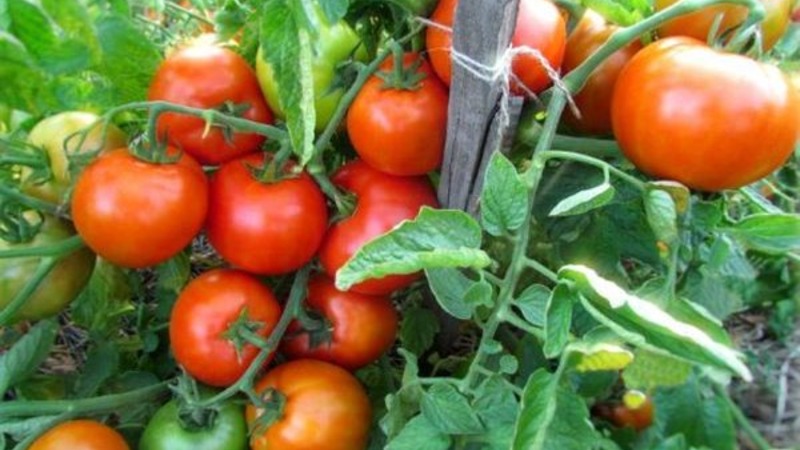
Another important factor when caring for a hybrid is weed removal... Weeds pull many nutrients out of the ground for the seedlings to grow. In addition, many pests that are dangerous to tomatoes live and breed in them.
Top dressing helps seedlings to receive additional nutrition for full development. They are brought in at least three times per season: during flowering, during the formation of ovaries and at the time of fruiting.
Fertilized with a complex of minerals or organic matter... During flowering, fertilizing is used with a predominant content of phosphorus and boric acid is added, and during fruiting, potassium substances are added. From organic matter, infusion of mullein or bird droppings is introduced in a ratio of 1:15.
Attention! A highly concentrated solution of organic compounds can cause root burns.
Features of care and possible difficulties
Despite the short stature, the plants must be tied to a support... When transplanting, wooden stakes or metal rods are installed next to the seedlings, to which the stem and fruitful branches are fixed as they grow. The culture is distinguished by an increased rate of fruiting, therefore, neither the stem nor the branches can withstand the weight of ripe fruits.
Form a bush into 2 stems... With this technique, you can achieve maximum returns, which is especially important when breeding on an industrial scale. Plants are regularly grazed due to the large number of side shoots. If they are not removed, this will lead to thickening of the plantings.
Diseases and pests
Vulnerability to late blight requires regular preventive measures... It should be remembered that planting a hybrid next to crops of the nightshade family (eggplant, pepper, potatoes) increases the risk of fungal diseases.
Regular prevention includes:
- moderate watering with control of the moisture level in the beds;
- regular loosening;
- hilling and mulching beds;
- soil cultivation with copper sulfate before planting;
- spraying plants with a manganese solution.
If the tomato is planted next to crops from the nightshade familyspray all the plants. When a fungus is affected, it is treated with fungicidal agents - "Fitosporin" or "HOM».
Of the pests for the hybrid, aphids, the Colorado potato beetle and the bear are dangerous... Medvedka moves underground and is hard to spot. Therefore, measures are taken in advance, burying chopped cloves of garlic or fish heads in the beds. With their unpleasant smell, they scare away the pest.
Colorado potato beetle harvested by handcarefully examining each seedling from all sides. In case of a large accumulation of the pest, the drug "Prestige" or "Commander" is used.
To keep aphids away from plants, each stem is treated with a soapy solution, which is prepared from one piece of laundry soap dissolved in a bucket of warm water.
Nuances when breeding in open ground and greenhouse
Greenhouse plants can grow beyond their stated height, reaching 90 cm... To limit the height of the crown, pinch, otherwise a lot of nutrients will be spent on the formation of unnecessary shoots.
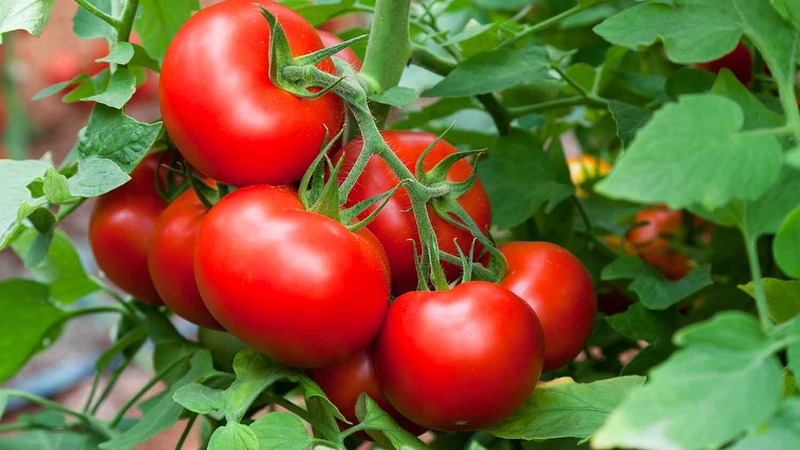
Before planting a tomato, the walls of protected structures are treated with Bordeaux liquid, destroying pathogenic flora. The annual replacement of the top layer of soil in the greenhouse is also important. Numerous fungal spores and pests overwinter on the soil surface, which in spring can cause great harm to plantings. If it is not possible to replace the top soil layer, the earth is carefully spilled with a hot solution of manganese and copper sulfate.
Regular ventilation of the greenhouse reduces air humidity and temperature... Overestimation of these indicators contributes to the successful development of bacterial spores. A regular supply of fresh air reduces the risk of disease. In addition, fresh air destroys the habitat of greenhouse pests.
In the greenhouse and in open beds, the lower leaves before the first fruitful branches are removed so that they do not come into contact with wet beds. When rotting, they will become a source of disease.
Harvesting and application of the crop
Thanks to the amicable ripening, the crop is harvested simultaneously and in large quantities... This is very convenient for selling on sales markets and preparing numerous winter blanks. Also, large quantities are used for processing for tomato products (juices, pastes, ketchups and sauces).
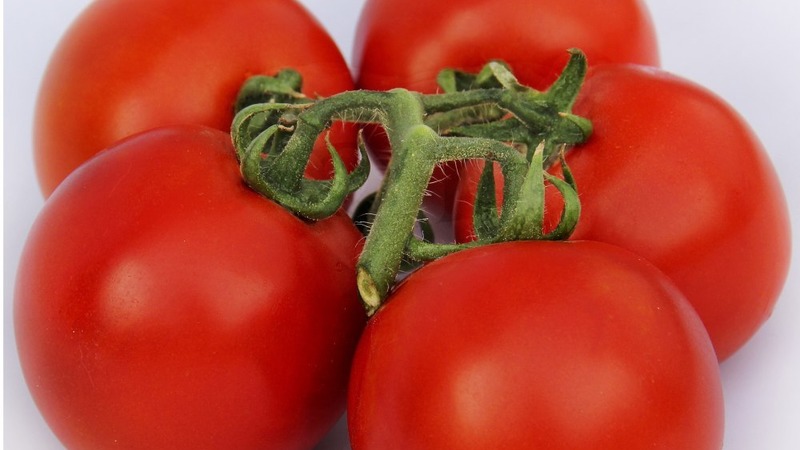
Larger tomatoes are used for fresh consumption, and the smaller tomatoes are canned whole - they look great due to the perfect shape. The high percentage of dry matter and sugar content gives the freshly squeezed juice an original taste, which is suitable for dietary nutrition.
Interesting. Due to its perfectly round shape and bright color, the tomato is used in advertising.
Ripe vegetables are stored for a long time and can withstand transportation at any distance.
Advantages and disadvantages of a hybrid
Let's start with the positive qualities of the variety:
- takes root in all regions;
- forms ovaries in any weather;
- unpretentious care;
- resistance to many diseases;
- the highest yielding hybrid;
- excellent fruit taste;
- perfect shape and color;
- the possibility of breeding for sale;
- long storage;
- long transportation;
- universal use.
The negative sides include:
- vulnerability to late blight;
- requires a garter;
- requires pinching.
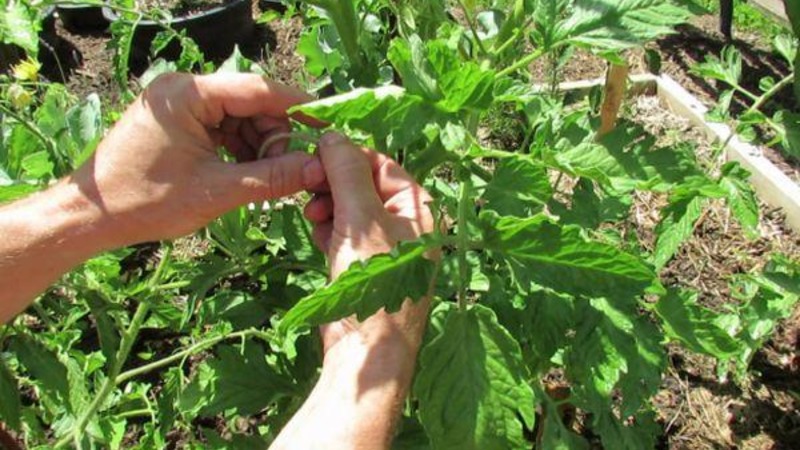
Farmers reviews
Farmers' reviews fully confirm the declared characteristics of the hybrid.
Sergey, Volgograd region: “I have been doing large-scale cultivation for a long time. Vityaz planted tomatoes for testing. The manufacturer did not deceive - the result exactly corresponds to the description of the variety on the package. The harvest exceeded my expectations. The culture was not sick throughout the season. I will plant more next year ".
Ekaterina, Saratov region: “I have been growing this hybrid for several years and I am happy with everything. Fruiting is excellent, I make a lot of blanks. I also tie up my stepson, otherwise there will be a lot of greenery. Ovaries are formed in any weather - this is important, since our climate is unstable. Bushes are small and compact ".
Conclusion
Known in all regions, the Vityaz f1 tomato continues to conquer gardeners, taking pride of place in the plots. Its high fruiting rate, resistance to many diseases, the ability to form ovaries in any conditions and easy care did not leave indifferent many gardeners.
Tomato is successfully grown not only in Russia, but also in Ukraine, as well as in Moldova.